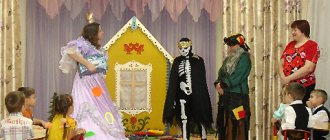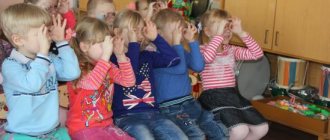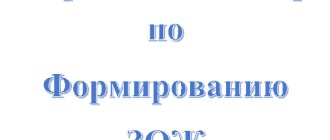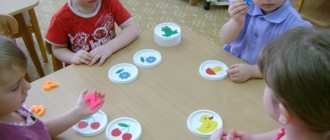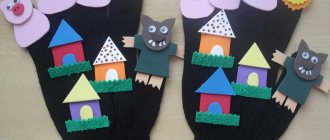A child of any age learns about the world around him, he always strives to learn something new. Parents are the first assistants in his difficult steps. Do not discourage your child from learning and learning something new.
Help your child, develop his attention. Teaching mathematics to preschoolers is an easy and even interesting process.
By learning something new together with your child, you will have a better relationship. Work with your child in a calm environment for 30–40 minutes every day. Don’t scold your child even if he doesn’t succeed, try to praise him. Next time he will try even better. If you see that your child is tired, postpone the lesson and let him rest.
Teach your child mathematics in the form of games and interesting exercises, mathematics tasks for preschoolers, while playing, the child quickly remembers.
We learn geometric bodies: cube, ball, cylinder, pyramid
Exercise one “Tell it right”
Tell us what geometric bodies are drawn in the following picture.
Exercise two “Tell me what you remember”
Tell us what geometric bodies are drawn in the following picture.
We learn to divide a circle and a square into two and four parts.
Take the circle it is shown in the first picture and divide the circle into two parts.
Exercise one “Draw and divide”
Take a piece of paper and a pencil, draw a circle on it, then divide it into two parts. If you manage to divide correctly, then divide the circle into four parts.
Exercise two “Divide the square”
Take a piece of paper and a pencil, draw a square on it, then divide it into two parts. If you manage to divide correctly, then divide the square into four parts.
See further:
- Math lessons for a 6-7 year old child
- Online games for girls
- Self education game
Educational math games for children:
Games to develop math skills
For child development, we have several educational games for preschool children.
Mathematics classes outside the preschool educational institution
Parents are also integral participants in the educational process. They can work with the child on their own, helping him learn the material.
It is permissible to use available options as counting material: candies, marmalades, dryers, cars, etc. Based on them, the numbers and composition of the number are explained.
You can find different online games, but it is better to use visual techniques. While walking, the child compares leaves, counts flowers or birds, looks for identical houses, etc.
Parents can do a special project with it. For example, count how many books, figurines, and other items are in the house. Adults help the child record data in a special table.
Important! Classes should be in the form of a game, otherwise the preschooler will quickly lose interest in what is happening and begin to become negativistic.
You can hang posters with numbers around the house. If a child learns “seven,” then draw this number and the same number of dots. Unnoticed, the child is asked to count the number of cutlets or other foods.
In order for a preschooler to learn shape and size, he is asked to work in the kitchen. Together with his parents he can make cookies and compare them. To do this, use templates or molds. He is asked to cut out seven sevens or other numbers from the dough.
Various puzzles “Fold the pattern”, “Seguin Boards”, “Dyenes Blocks” and others will help diversify the learning process. They can be used by adults at home. Parents must follow one simple rule: the child is given the opportunity to find the answer on his own.
Educational games for preschool children
Game 1 "Keen Eye"
The game "Keen Eye" develops attention and improves memory.
The main point of the game is to remember where the bird, ship and sun are and then indicate where they were.
The screen opens for a few seconds and shows the sea, a bird, a ship and the sun. We need to remember where they are. Then they disappear and the question appears on the screen: “Click where the ship was.” You must remember and indicate where the ship was. Then the question is displayed: “Click where the bird was.” You must remember and indicate where the bird was. Then the question is displayed: “Click where the sun was.” You must answer where the sun was and so on. If you answered correctly, you score points and continue playing.
Play now
Game 2 "Pathfinder"
The Pathfinder game develops memory and attention.
The main essence of the game is to remember the tracks of animals and repeat them.
In this game, animal tracks appear on the screen, look carefully and remember in what order the tracks appear. Then they disappear, you need to show which trace appeared first, and which second, and so on. Each time the location of the tracks and their order of appearance will change. If you answered correctly, you score points and continue to play.
Play now
Game 3 "BrainFood"
The BrainFood game develops memory and attention.
The main essence of the game is that in each round a set of elements is shown; you must choose from the set the one that has not yet been selected in previous rounds.
In this game, drinks and food are offered on the screen. You have to choose one thing. In each subsequent round, you must choose a different dish that differs from the previously selected ones. You must remember and always choose different dishes and drinks. If you answer correctly, you gain points and play further.
Play now
Game 4 "Diamonds"
The game "Diamonds" develops memory and concentrates attention.
The main essence of the game is to remember the order of the figures that light up on the screen and repeat it.
The figures light up on the screen one by one, remember the order in which these figures light up, then they disappear; you need to remember in what order they appeared and repeat it. You can do this using the mouse or the cursor on the keyboard. If you answer correctly, you score points and continue playing.
Play now
Game 5 “Signal lights”
The game “Signal Lights” trains:
- Spatial memory.
- Working memory.
- Planning.
You need to remember the order of lighting the lamps and reproduce it. You need to answer as quickly as possible. Lamps appear on the screen, they turn yellow in turn, you need to remember the order in which they light up. Then you need to remember this order and click on the lamps in the correct order using the mouse. If you press correctly, the lamp lights up green and you continue playing, and if you make a mistake and press incorrectly, the lamp lights up red.
Play now
Game exercises
The program of any preschool educational institution contains all stages of training. Therefore, you should not start the process from the middle, as the child will not learn the material. Initially, children are introduced to the definition of quantity.
To do this, use toys or color pictures that can be compared. Dolls, trees, animals, etc. will do. You can act out a small scene: Big Winnie the Pooh wants a small toy as a gift. And the little donkey Eeyore hopes to get a big ball.
Important! You can select characters based on the child’s interests. Some people like cars, others like dolls.
The work program contains certain goals. Children are taught to relate shapes. To do this, take cardboard rectangles in which holes are cut out in the form of different geometric shapes. The task of preschoolers is to choose a suitable patch.
Research activities during a walk in the preparatory group
Showing visual material is an integral part of learning. Toys, counting material, and color pictures are suitable for this. All this is necessary in order to correctly form ideas about numbers and computational operations.
Before children begin to learn numbers, they need to understand the difference between “one” and “many.” For this purpose, counting material and appropriate cards are used.
Preschoolers are shown one toy duck and several ducklings, asking them to compare and guess what the difference is. Only after this has been mastered do they move on to mastering numbers.
The definition of “more or less” is gradually being formed. Do not rush your child if difficulties arise. Everyone has a different learning speed.
When children master counting to 5-6, they are offered more complex tasks. Cards are given with hedgehogs holding different numbers of apples on needles. Preschoolers should arrange them in ascending or descending order.
According to the Federal State Educational Standard, by the end of training at a preschool educational institution, a child must have certain competencies. Generalization, classification, exclusion, comparison and other mathematical operations are available to him. This is important for good learning in school.
There are different simulators for developing counting skills
There is a lot of debate about the use of new technologies in the form of presentations and interactive games. Some deny their benefits, while others see the future in this. Children enjoy computer activities and enjoy such entertainment.
Courses for the development of intelligence
In addition to games, we have interesting courses that will perfectly pump up your brain and improve your intelligence, memory, thinking, and concentration:
Development of memory and attention in a child 5-10 years old
The purpose of the course: to develop the child’s memory and attention so that it is easier for him to study at school, so that he can remember better.
After completing the course, the child will be able to:
- 2-5 times better to remember texts, faces, numbers, words
- Learn to remember for a longer period of time
- The speed of recalling the necessary information will increase
Sign up for a courseRead more
Secrets of brain fitness, training memory, attention, thinking, counting
If you want to speed up your brain, improve its functioning, improve your memory, attention, concentration, develop more creativity, perform exciting exercises, train in a playful way and solve interesting problems, then sign up! 30 days of powerful brain fitness are guaranteed to you:)
Sign up for a courseRead more
Super memory in 30 days
As soon as you sign up for this course, you will begin a powerful 30-day training in the development of super-memory and brain pumping.
Within 30 days after subscribing, you will receive interesting exercises and educational games in your email that you can apply in your life.
We will learn to remember everything that may be needed in work or personal life: learn to remember texts, sequences of words, numbers, images, events that happened during the day, week, month, and even road maps.
Sign up for a courseRead more
How to improve memory and develop attention
Free practical lesson from advance.
Sign up for freeRead more
Money and the Millionaire Mindset
Why are there problems with money? In this course we will answer this question in detail, look deep into the problem, and consider our relationship with money from psychological, economic and emotional points of view. From the course you will learn what you need to do to solve all your financial problems, start saving money and invest it in the future.
Sign up for a courseRead more
Speed reading in 30 days
Would you like to quickly read books, articles, newsletters, etc. that interest you? If your answer is “yes,” then our course will help you develop speed reading and synchronize both hemispheres of the brain.
With synchronized, joint work of both hemispheres, the brain begins to work many times faster, which opens up much more possibilities. Attention , concentration , speed of perception are enhanced many times over! Using the speed reading techniques from our course, you can kill two birds with one stone:
- Learn to read very quickly
- Improve attention and concentration, as they are extremely important when reading quickly
- Read a book a day and finish your work faster
Sign up for a courseFree lesson
We speed up mental arithmetic, NOT mental arithmetic
Secret and popular techniques and life hacks, suitable even for a child. From the course you will not only learn dozens of techniques for simplified and quick multiplication, addition, multiplication, division, and calculating percentages, but you will also practice them in special tasks and educational games! Mental arithmetic also requires a lot of attention and concentration, which are actively trained when solving interesting problems.
Sign up for a courseRead more
How to conduct classes with a child 6-7 years old
A child in preschool age has great developmental potential and cognitive abilities. Parents simply need to help their child realize his potential. The time spent will definitely pay off. Help from parents can make future schooling enjoyable. And the adults themselves will not be upset about their child’s academic performance.
Activities with preschoolers
Here are a few tips for getting the most out of your workouts:
- Classes shouldn't be boring.
The best motivation for learning is interest. It turns children into creative individuals and provides an opportunity to feel satisfaction from their activities.
- Exercises must be repeated constantly.
Improvement in mental abilities is tested with time and duration of practice. If you cannot complete the exercise, you need to take a break and return to it later. A less complex or equal version of the task will also solve the problem.
- Be patient and take your time. It is unacceptable to offer a child tasks that exceed his real capabilities.
- Insufficient progress in classes, according to adults, should not cause anxiety in parents.
- The duration of lessons should be moderate, exceeding is unacceptable.
Testing preschoolers for school readiness according to the Federal State Educational Standard
If a child has lost attention due to fatigue, it is recommended to occupy him with other activities. It is necessary to determine the degree of endurance of the baby in order to slightly increase the duration of the lesson each time.
- The game form of learning is best suited for preschoolers.
- It is extremely important to regularly support the child and praise him for his perseverance and efforts. It is not recommended to compare a preschooler with other children. This helps build self-confidence.
On a note! Working with a child is joy and pleasure, not hard work. This is the best opportunity to establish friendships with your child.

